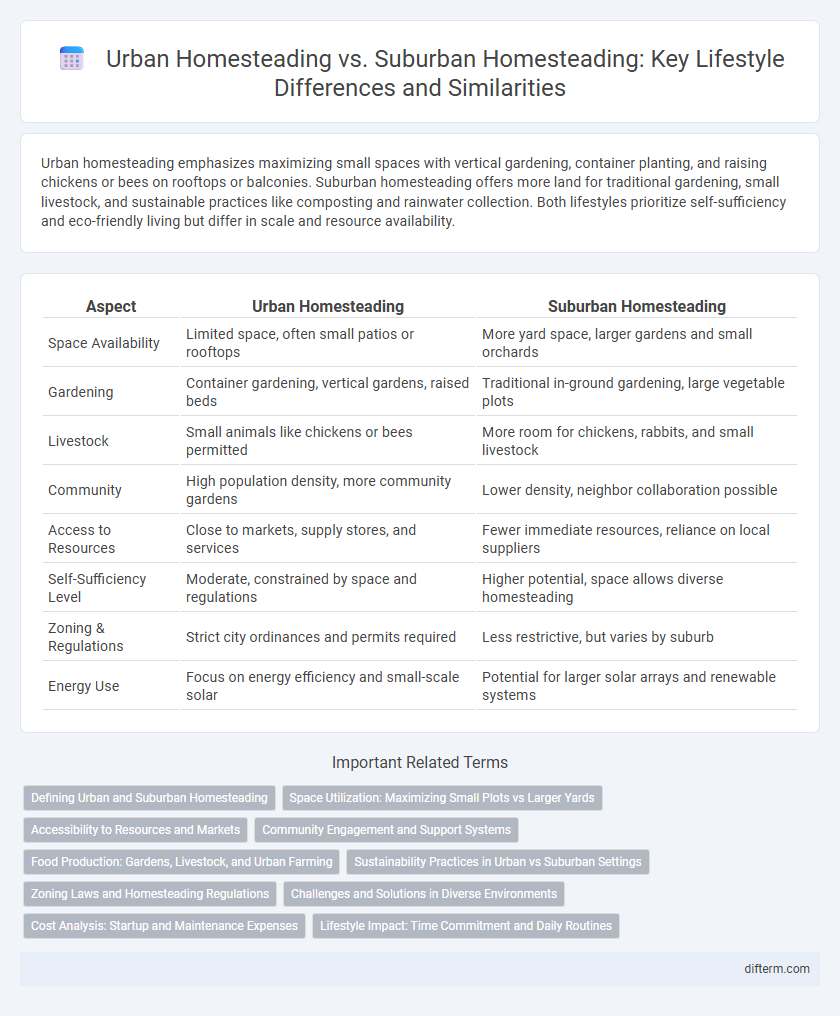Urban homesteading emphasizes maximizing small spaces with vertical gardening, container planting, and raising chickens or bees on rooftops or balconies. Suburban homesteading offers more land for traditional gardening, small livestock, and sustainable practices like composting and rainwater collection. Both lifestyles prioritize self-sufficiency and eco-friendly living but differ in scale and resource availability.
Table of Comparison
| Aspect | Urban Homesteading | Suburban Homesteading |
|---|---|---|
| Space Availability | Limited space, often small patios or rooftops | More yard space, larger gardens and small orchards |
| Gardening | Container gardening, vertical gardens, raised beds | Traditional in-ground gardening, large vegetable plots |
| Livestock | Small animals like chickens or bees permitted | More room for chickens, rabbits, and small livestock |
| Community | High population density, more community gardens | Lower density, neighbor collaboration possible |
| Access to Resources | Close to markets, supply stores, and services | Fewer immediate resources, reliance on local suppliers |
| Self-Sufficiency Level | Moderate, constrained by space and regulations | Higher potential, space allows diverse homesteading |
| Zoning & Regulations | Strict city ordinances and permits required | Less restrictive, but varies by suburb |
| Energy Use | Focus on energy efficiency and small-scale solar | Potential for larger solar arrays and renewable systems |
Defining Urban and Suburban Homesteading
Urban homesteading involves cultivating food, raising small livestock, and practicing sustainable living within city limits, often on limited space like balconies or small yards. Suburban homesteading typically includes larger plots of land, allowing for extensive gardening, bigger livestock, and more self-sufficient practices while still being close to urban amenities. Both lifestyles emphasize sustainability but differ significantly in scale, resources, and community interaction.
Space Utilization: Maximizing Small Plots vs Larger Yards
Urban homesteading excels in maximizing limited space through vertical gardening, container planting, and multi-functional areas that support food production and sustainability within small plots. Suburban homesteading benefits from larger yards, allowing for expansive vegetable gardens, fruit trees, livestock, and composting systems that enhance self-sufficiency and outdoor living. Efficient space utilization in both settings drives innovative design strategies tailored to plot size and environmental conditions.
Accessibility to Resources and Markets
Urban homesteading offers greater accessibility to diverse local markets, farmers' markets, and community-supported agriculture programs, enabling easier sourcing of organic and specialty products. In contrast, suburban homesteading generally provides more expansive space for gardening and livestock but may face challenges in quick access to niche markets and resource-sharing networks. Proximity to urban centers enhances resource availability for city dwellers, while suburban homesteaders often rely on personal transportation to reach broader commercial hubs.
Community Engagement and Support Systems
Urban homesteading fosters stronger community engagement through shared resources, neighborhood workshops, and local markets, creating tight-knit support networks. Suburban homesteading benefits from spacious properties that encourage family participation and neighborhood collaboration but often relies more on individual efforts than communal initiatives. Both lifestyles emphasize sustainability, yet urban settings provide more opportunities for diverse community interaction and cooperative projects.
Food Production: Gardens, Livestock, and Urban Farming
Urban homesteading emphasizes compact gardens, container planting, and vertical farming techniques to maximize limited space, focusing on herbs, vegetables, and small livestock like chickens or rabbits. Suburban homesteading benefits from larger yards that support extensive vegetable plots, orchards, and diverse livestock such as goats, chickens, and bees, enabling greater self-sufficiency. Both approaches integrate sustainable practices, but urban farming prioritizes space-efficient solutions while suburban homesteading leverages expanded land for diversified food production.
Sustainability Practices in Urban vs Suburban Settings
Urban homesteading emphasizes sustainable practices such as vertical gardening, rainwater harvesting, and composting in limited spaces, maximizing resource efficiency and reducing urban waste. Suburban homesteading benefits from larger plots, enabling extensive food production, renewable energy installations like solar panels, and livestock keeping, promoting self-sufficiency and biodiversity. Both settings prioritize sustainability but adapt strategies to spatial constraints and environmental impact within their unique ecosystems.
Zoning Laws and Homesteading Regulations
Urban homesteading faces strict zoning laws that often limit livestock, garden sizes, and building modifications, while suburban homesteading typically allows larger plots with fewer restrictions on raising animals and constructing outbuildings. Both environments require compliance with local homesteading regulations, but urban areas demand adherence to more complex permits and inspections due to higher population density. Understanding municipal codes and homeowners' association rules is essential for successful homesteading in either setting.
Challenges and Solutions in Diverse Environments
Urban homesteading faces challenges such as limited space, restricted sunlight, and soil contamination, requiring innovative solutions like vertical gardening, hydroponics, and raised beds with clean soil. Suburban homesteading deals with larger plots but often encounters stricter zoning laws, wildlife interference, and water management issues, addressed through permaculture design, fencing, and rainwater harvesting systems. Both environments demand tailored approaches to maximize sustainability and productivity despite their unique constraints.
Cost Analysis: Startup and Maintenance Expenses
Urban homesteading often incurs higher startup costs due to limited space requiring vertical gardening solutions and advanced composting systems, while suburban homesteading benefits from larger plots enabling traditional garden setups with lower initial investments. Maintenance expenses in urban homesteads tend to include higher water and energy costs, alongside specialized pest control, whereas suburban homesteading sees moderate upkeep costs with easier access to local resources and community tools. Cost analysis reveals suburban homesteading as generally more economical long-term, though urban homesteading can yield space-efficient sustainability despite higher initial expenditures.
Lifestyle Impact: Time Commitment and Daily Routines
Urban homesteading demands a flexible time commitment, integrating small-scale gardening, composting, and DIY projects within limited spaces, often fitting activities into daily urban schedules. Suburban homesteading requires more consistent labor, with larger gardens, animal care, and property maintenance shaping daily routines that emphasize early mornings and extended hands-on work. Both lifestyles foster sustainability but differ significantly in time allocation and the structuring of everyday tasks.
Urban Homesteading vs Suburban Homesteading Infographic

 difterm.com
difterm.com